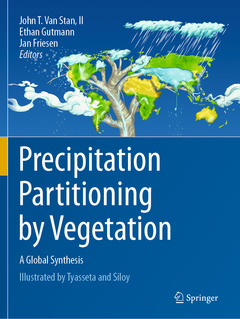Description
Precipitation Partitioning by Vegetation, 1st ed. 2020
A Global Synthesis
Coordinators: Van Stan, II John T., Gutmann Ethan, Friesen Jan
Language: English
Subjects for Precipitation Partitioning by Vegetation:
Keywords
Vegetation canopies; Precipitation planning; Ecohydrology; Precipitation partitioning; Climate change and partitioning; Precipitation and ecohydrological systems; Canopy precipitation partitioning; Rainfall partitioning by vegetation; Rainfall-runoff; Throughfall and stemflow; Precipitation interception; Canopy drip; Environmental Geography; meteorology
Publication date: 08-2021
281 p. · 21x27.9 cm · Paperback
Publication date: 01-2020
281 p. · 21x27.9 cm · Hardback
Description
/li>Contents
/li>Biography
/li>Comment
/li>
This book presents research on precipitation partitioning processes in vegetated ecosystems, putting them into a global context. It describes the processes by which meteoric water comes into contact with the vegetation's canopy, typically the first surface contact of precipitation on land. It also discusses how precipitation partitioning by vegetation impacts the amount, patterning, and chemistry of water reaching the surface, as well as the amount and timing of evaporative return to the atmosphere. Although this process has been extensively studied, this is the first review of the global literature on the partitioning of precipitation by forests, shrubs, crops, grasslands and other less-studies plant types.
The authors offer global contextualization combined with a detailed discussion of the impacts for the climate and terrestrial ecohydrological systems. As such, this comprehensive overview is a valuable reference tool for a wide range of specialists and students in the fields of geoscience and the environment.
Foreword.- Chapter 1. History of canopy precipitation partitioning.- Chapter 2. Measurement of canopy interception.- Chapter 3. Measurement of throughfall.- Chapter 4. Measurement of stemflow.- Chapter 5. Residence time of precipitation entrained as throughfall and stemflow.- Chapter 6. Dissolved organic matter.- Chapter 7. Dissolved inorganic solutes.- Chapter 8. Isotopic composition.- Chapter 9. Particulate matter (including microbes) .- Chapter 10. Modelling of precipitation partitioning.- Chapter 11. Modelling of canopy exchange.- Chapter 12. Differences among precipitation types (Rain, fog, snow, rime) .- Chapter 13. Differences between plant functional types.- Chapter 14. Differences with stand age and management.- Chapter 15. Global patterns in precipitation partitioning.- Chapter 16. Relevance of precipitation partitioning to the global climate system.- Chapter 17. Precipitation recycling.- Chapter 18. Arboreal epiphytes and hemiparasites.- Chapter 19. Treehole ecosystems.-Chapter 20. Soil erosion.- Chapter 21. Soil physicochemical properties.- Chapter 22. Soil microbial community structure and function.- Chapter 23. Streams.- Chapter 24. Soil and groundwater .- Chapter 25. Reflections & future directions: Research opportunities in canopy precipitation partitioning.- Index.
Dr. Van Stan is an ecohydrologist at Georgia Southern University in Savannah, Georgia (USA). He enjoys collecting field observations of water and elemental fluxes in vegetated ecosystems during storms—and developing sensors to overcome observational limitations when they arise. He has worked at sites in North and Central America and Europe to improve our understanding of how precipitation partitioning affects other ecosystem processes within, above and below plant canopies.
Dr. Gutmann is a hydrologist in the Research Applications Lab at the National Center for Atmospheric Research in Boulder, Colorado (USA). His background in hydrology, geology, and computer science found a happy marriage in remote sensing and hydrological and atmospheric modeling. A passion for the outdoors has taken him to remote corners of the world, climbing mountains in Peru, Nepal and Tanzania. Ethan also enjoys scientific outreach, having dabbled in science blogging at arstechnica and science videography with Earth Initiatives.
Dr. Friesen is an ecohydrologist at the Department of Catchment Hydrology, Helmholtz Centre for Environmental Research – UFZ, Leipzig (Germany). His research primarily focuses on forest ecohydrology, remote sensing, and sensor development where he applies and develops new monitoring solutions to bridge the gap between site studies and remote sensing. He has extensive experience in semi-arid and data scarce countries such as Ghana, Burkina Faso, Nigeria, and Oman and his work has a strong connection to water management issues.




